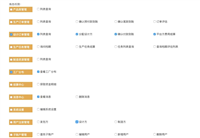angular获取普通dom元素的方法
通过模板变量名获取
import { component, viewchild, afterviewinit } from '@angular/core';
@component({
selector: 'my-app',
template: `
<h1>welcome to angular world</h1>
<p #greet>hello {{ name }}</p>
`,
})
export class appcomponent {
name: string = 'semlinker';
@viewchild('greet')
greetdiv: elementref;
ngafterviewinit() {
console.log(this.greetdiv.nativeelement);
}
}但我发现用这种方法获取ngif渲染的元素时得到的是undefined
<div *ngif="isbuttngrop" (click)="dropbtnclick($event)">
<div cdkdroplist #droplist [cdkdroplistconnectedto]="_connectabledroplists" (cdkdroplistdropped)="drop($event)">
<div *ngfor="let item of itemdatas" (click)="onitemclick($event,item)" cdkdrag
(cdkdragstarted)="startdragging($event)" [cdkdragdata]="{ item }">
</div>
</div>
</div>将static改成false 获取
@viewchild('droplist', { read: cdkdroplist, static: false }) droplist: cdkdroplist;
ngafterviewinit(): void {
if (this.droplist) {
console.log(this.droplist)
}
}通过这个也是实现了一个buttongroup拖拽button到 列表的功能,列表的button也能拖拽到 buttongroup
用的也是angular自带的 cdk/drag-drop
import { cdkdragdrop, cdkdroplist, moveiteminarray } from '@angular/cdk/drag-drop';自己实现的思路
官网的文档和demo比较简单,没有讲到跨组件的实现,简单记录一下自己实现的思路。
将需要拖拽的元素加入cdkdroplist,并且在a组件和b组件都初始化的时候获取到需要拖拽的dom元素,将他们各自注册到store中,带上特殊的componentid。
a、b组件加上cdkdroplistconnectedto 这决定着组件可以跨组件拖动到哪里,用_connectabledroplists变量。同样的,在页面初始化时,通过rxjs的流订阅特殊的componentid,去获取到当有拖拽list注册到store中时的变化,并且赋值给_connectabledroplists数组。
const parentid = this.storeservice.getproperty(this.pageid, this.componentid, 'parentid');
this.dragdropservice.getdraglistsasync(this.pageid, parentid.value)
.pipe(takeuntil(this.destroy))
.subscribe(droplists => {
this._connectabledroplists = droplists || [];
});
this.storeservice.getpropertyasync(this.pageid, this.componentid, 'children')
.pipe(takeuntil(this.destroy)).subscribe(result => {
if (!result || result.length === 0) {
this._children = [];
this._dragdata = [];
this.changeref.markforcheck();
} else {
const dropbuttonarray = result.filter((item) => {
const itemtype = this.storeservice.getproperty(this.pageid, item, 'componenttype');
if (itemtype === admcomponenttype.dropdownbutton) return item;
});
if (dropbuttonarray.length > 0) {
this._connectabledroplists = [];
dropbuttonarray.foreach(comid => {
this.dragdropservice.getdraglistsasync(this.pageid, comid)
.pipe(takeuntil(this.destroy))
.subscribe(droplists => {
this._connectabledroplists.push(...droplists);
});
});
}
}
});因为a组件是b组件的父级,所以需要通过当前组件id获取到父级id,再获取到拖拽元素
通过cdkdragdata 把拖拽的元素的value,id等值带上
通过(cdkdroplistdropped)="drop($event)",注册拖拽结束的回调事件
drop回调事件处理拖拽结束后的数据处理,这里涉及到项目低代码的一些组件数据处理,大致是删除oldparent children, 然后新的parent节点加上,再更改当前组件的parent节点。同时这里涉及到buttongroup下面的button本身也可以互相拖拽的处理,所以也需要一层判断来特殊处理。
drop(event: cdkdragdrop<any>) {
if (event.previouscontainer != event.container) {
const { eventdata } = event.item.data;
const componentid = eventdata[event.previousindex];
const oldparentid = this.storeservice.getproperty(this.pageid, componentid, 'parentid', false)?.value;
// delete oldparent children
const oldparent = this.storeservice.getproperties(this.pageid, oldparentid);
const index = oldparent.children.indexof(componentid);
oldparent.children.splice(index, 1);
// add newparent children
const oldchildren = this.itemdatas.map(x => x.id.value);
oldchildren.splice(event.currentindex, 0, componentid);
this.storeservice.setproperty(this.pageid, componentid, 'parentid', { value: this.componentid }, [[this.pageid, componentid]]);
this.storeservice.setproperty(this.pageid, oldparentid, 'children', oldparent.children, [[this.pageid, oldparentid]]);
this.storeservice.setproperty(this.pageid, this.componentid, 'children', oldchildren);
this.changedetector.markforcheck();
return;
}
moveiteminarray(this.itemdatas, event.previousindex, event.currentindex);
const children = this.itemdatas.map(x => x.id.value);
this.storeservice.setproperty(this.pageid, this.componentid, 'children', children);
}这样子组件和父组件的内部元素互相拖拽,也就能实现了
以上就是angular获取ngif渲染的dom元素示例的详细内容,更多关于angular获取ngif渲染的资料请关注代码网其它相关文章!







发表评论